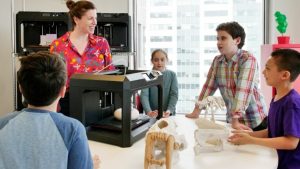3D printing is revolutionizing the way artists approach their craft, offering them the ability to explore new creative possibilities and even reinterpret classical art. By allowing artists to create replicas or new versions of famous sculptures and artworks, 3D printing provides a hands-on opportunity to interact with pieces that were once confined to museums. This technology opens up a world of artistic expression, enabling both established and budding artists to push the boundaries of their creativity.
Painting 3D Prints
One of the exciting applications of 3D printing in art is the ability to print and then paint 3D models. With the availability of STL files on platforms like CGTrader, MyMiniFactory, and Thingiverse, artists can easily access and print any 3D model they desire. Using light-colored resins such as Water-Washable Resin – Model Gray Resin, ABS-like Creamy White Resin, Beige-Flex Resin, or Phrozen Aqua-Ivory 4K, these prints serve as a blank canvas for artists to experiment with colors, patterns, and textures.
For example, art students might print iconic landmarks like the Eiffel Tower or the Statue of Liberty and then customize them with a variety of colors to showcase their creativity. Historical statues like the Moai statue or Queen Nefertiti are also available as STL files, allowing students to paint or even modify these models using design software, creating unique interpretations of these classic pieces.
Sculptures
3D printing also empowers artists to create sculptures with intricate details that would be challenging to achieve using traditional sculpting methods. Whether recreating famous sculptures or designing entirely new pieces, artists can leverage the precision of 3D printing to bring their visions to life. This technology allows for experimentation with forms, materials, and scales that might have been impractical or impossible before.
Artists can experiment with different materials and textures, creating sculptures that combine traditional artistic techniques with modern technology. The ease of tweaking and refining designs in 3D software before printing also allows for a more iterative and exploratory creative process.
3D printing in art is not just about reproducing existing works but about pushing the boundaries of what is possible, blending the old with the new, and enabling artists to realize their most ambitious creative visions.

Artists can also use 3D printing to create sculptures with CAD software such as Mudbox, SelfCad, or ZBrush. With 3D printing, sculptures featuring unique curvatures and shapes can be easily produced. These types of sculptures would be challenging to create using traditional sculpting techniques due to technical limitations.
3D printers such as the Sonic Mighty 4K and Sonic Mega 8K can produce detailed and large art sculptures in one go, eliminating the need to assemble different parts together.
Artists can now even 3D print voice sculptures and sound recordings, turning something that could previously only be heard into a tangible, physical form that people can view. There’s even a website that allows users to upload their sound files, design their model, and download the STL file directly for printing. How creative is that?!
Large-Scale Art Pieces

Large-Scale Art Pieces
Sculptures and other large-scale art pieces can be effortlessly created using advanced 3D printers like the Sonic Mighty 4K and the Phrozen Sonic Mega 8K. These printers are capable of producing substantial and intricate art pieces that can be showcased in exhibitions, museums, and public spaces. The large build volumes of these printers allow for detailed textures and complex designs that are uniquely suited to big-scale projects.
One of the advantages of 3D printing large-scale art is the ability to print pieces in separate sections. This method simplifies transportation and assembly, making it more practical to handle and set up large installations at various venues. The modular approach also reduces the labor and logistics involved in creating and displaying big art pieces.
For instance, the French startup Lyon Drawn used a 3D printer to create enormous lion sculptures, which were then painted and exhibited in a stadium. By printing the lions in segments and assembling them on-site, the team was able to manage the installation process efficiently and achieve a striking visual impact.
Miniature Art Pieces

Resin 3D printing isn’t just for large-scale creations; it’s also perfect for producing miniature art pieces with exceptional detail. One standout example is the work of South Korean digital sculptor Jisoo Kim, whose intricate and adorable 3D models showcase the impressive capabilities of resin printing.
The Phrozen Sonic Mini 4K is particularly adept at capturing the fine details in miniature models. This printer allows artists to create highly detailed and unique miniature designs that can be used for various purposes, including decorative items, collectibles, and display pieces. The high resolution of the Sonic Mini 4K ensures that every small detail is rendered with clarity and precision.
Miniature art pieces produced with resin 3D printing can be used to enhance homes, museums, exhibitions, and even educational settings. They offer a way to bring detailed and creative designs to life on a small scale, making them ideal for showcasing artistic talent and craftsmanship in a compact format. Whether you’re creating models for display or educational purposes, resin 3D printing opens up new possibilities for miniature art.

Miniature Artistry with 3D Printing
Today’s miniature artists have the remarkable ability to design and print highly detailed creations, from intricate busts and skulls to any imaginative 3D model they envision. The precision offered by resin 3D printing allows for the reproduction of fine details and complex designs that might otherwise be challenging to achieve.
For inspiration, consider a project by a museum in Poland that employed 3D scanning to digitize Baroque-era furniture. The museum then printed miniature replicas of these historic pieces, allowing visitors to appreciate the fine craftsmanship and intricate details of the period. Such applications highlight how 3D printing can breathe new life into historical artifacts and provide a tangible connection to the past.
The Future of 3D Printing in Art
Looking ahead, 3D printing is set to revolutionize the art world by empowering artists to bring their most ambitious and unconventional designs to life. This technology enhances both the efficiency and precision of art creation, making it easier to produce accurate reproductions of famous artworks or experiment with novel artistic concepts.
3D printing offers artists a versatile tool for practicing their craft, refining their skills, and pushing the boundaries of traditional art forms. By enabling the creation of detailed reproductions and innovative new designs, 3D printing significantly boosts both creativity and productivity in the art world, opening up exciting possibilities for the future.










